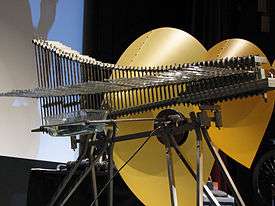Baschet Brothers

The Baschet Brothers refers to two French brothers named François Baschet (born 30 March 1920, in Paris; died 11 February 2014) and Bernard Baschet (born 24 August 1917, Paris; died 17 July 2015[1]) who collaborated on creating sound sculptures and inventing musical instruments, such as the cristal Baschet. François Baschet was a sculptor and Bernard Baschet an engineer. The Baschet Brothers invented the inflatable guitar, the aluminum piano and many other experimental musical instruments. They created an "educational instrumentarium" for exposing young people to musical concepts.

. Baschet‘s research started in the 1950s artistic turmoil, soon turning the two brothers into the pioneers of sound sculpture, in addition to making them highly requested by musicians, composers, experimental directors.
Career
François had wanted to be an artist, but his father warned him against pursuing the unstable life of an artist. He decided to study business in college, but felt no passion for it. After World War II, which had interrupted his education, he decided to travel around the world. He brought with him on his trip a guitar to help him earn a living, but wanting something more portable he invented an inflatable guitar using a balloon and a collapsible wood neck. He continued to perform with this guitar upon his return to Paris. Soon he and his brother, who had studied engineering, began collaborating on sculptural musical instruments.
Beginning in 1952, the Baschets started research into all existing musical instruments and put this knowledge to work in creating dozens of structures sonores (i.e., 'sonorous sculptures'). Their visually striking instruments were crafted out of steel and aluminum and amplified by large curved conical sheets of metal, and are most often easy to play and accessible to people with any level of experience. One example of this is the Hemisfair Musical Fountain, which consists of an array of posts at the top of which are groups of conical sound diffusers, and above them circles of metal prongs. These are played by jets of water aimed by observers.
In 1954, the brothers met Jacques and Yvonne Lasry. Jacques was a pianist and composer and Yvonne was an organist. The four formed an association which they called "Lasry-Baschet Sound Structures." They held their first concerts in 1955. The group was successful and in 1960 were asked by Jean Cocteau to provide music for his film, Le Testament d'Orphée. The group toured, appearing on television shows including The Ed Sullivan Show. In 1966 they were invited to hold an exhibition at the Museum of Modern Art and director Alfred Barr purchased a sculpture for the museum's collection. Their tune Manège was also used as theme for the Granada TV program Picture Box, which ran in the United Kingdom from 1966 to 1990.
In the 1960s the Lasrys emigrated to Israel. In 1977 Bernard met Michel Deneuve, a musician, who joined them, starting a new association, and assisted in creating instruments. Deneuve was especially dedicated to working on their instrument called the "Cristal".[2]
Discography
- “Crystal”, Michel Deneuve, the double album for sixty years of the birth of the Crystal. micheldeneuve@free.fr, 2014
- "Voyage autour du Cristal", Michel Deneuve, Rue Stendhal Distribution, new edition, 2013
- "Danse de Dunes", Michel Deneuve, Rue Stendhal Distribution, new edition, 2013
- Les Sculptures Sonores - The First Fifty Years, FMR Records, CD, 1999
- 4 Espaces Sonores, with Bernard Baschet, Michel Deneuve and Alain Dumont, 1982
- "Seize Nouvelles D'Ailleurs" (LP), Michel Deneuve, Sysmo Records, 1983
- "L'Art Du Cristal" (LP), Michel Deneuve, Arion, 1984
- Structures for Sound, Museum of Modern Art, 10" vinyl, 1965
Bibliography
- Frauensohn, Danièle and Deneuve, Michel. Bernard Baschet : Chercheur et sculpteur de sons. France: L'Harmattan, 2007. ISBN 978-2-296-04171-4
- Mémoires sonores with preface by Yehudi Menuhin. France: L'Harmattan, 2007. ISBN 978-2-296-03383-2
References
- ↑ Heyligen, Julien (19 July 2015). "Bernard Baschet, le génial inventeur d’instruments, est décédé". Le Parisien (in French). Retrieved 19 July 2015.
- ↑ ♙♙Baschet website
External links
- Les Sculptures Sonores, official website of the Baschet brothers; contains a photograph of Bernard and François Baschet.
- Structures Sonores, official website of the workshop led by Frédéric Bousquet.
- Association Structures Sonores Baschet et Pédagogie.
- Musical Ensemble based on sound sculptures and cristal.
- L’instrumentarium Baschet.
- Taller Baschet a Barcelona. Official website of the Baschet workshop at the Arts Faculty of Universitat de Barcelona, research group for the conservation, diffusion and development of the Baschet soundsculpture, in collaboration with Bernard and François Baschet.
- Baschet Brothers in American public collections, on the French Sculpture Census website
